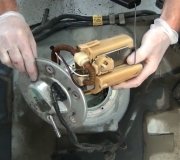First of all, once it stalls, turn the ignition switch off, wait a few seconds, then turn the switch back to "run" and listen for the hum of the fuel pump. Listen by the tank if you have to while a helper turns the switch on. The pump should run for only one second then stop. THAT is where the pressure in the system comes from. You were told "the fuel pump is not working and after the engine is off, the pressure builds in the fuel system which allows it to drive a short distance". You have to ask "why is that pressure building"? It sounds like your mechanic thinks the gas in the tank is warming up and expanding, which can happen, but not even close to enough for the engine to run. You need somewhere between 35 and 45 psi for fuel to spray from the injectors. You won't build that much pressure on the hottest day of summer. A second possibility is there is a leak detection pump that puts the fuel tank and vapor recovery system into 2 pounds of pressure, then it watches to see how long it takes for that pressure to bleed down. That's where the loose gas cap is detected. That 2 psi will hardly make fuel flow through the lines much less spray from an injector. Where the system pressure DOES come from is that one-second burst from the pump when you turn on the ignition switch. To get back to that story, if you hear the pump run for that one second, it is working, period. No need to look further at the pump circuitry. Once the pump stops running, the engine can run no more than 2 to 5 seconds on that stored pressure, certainly not a quarter mile or more. When the stalling problem occurs, turn the ignition switch off, wait a good ten seconds, then listen for the hum of the pump when you turn the switch back on. My bet is you will hear it, meaning there is now pressure in the system, yet the engine won't restart. That is because after that initial one second, the pump, ignition coil, injectors, and a few other things are SUPPOSED to get power again during engine cranking but are not. Let me back up a minute and clarify the operation. All of these things get their power from the automatic shutdown relay two times. The Engine Computer turns that relay on for one second when you turn the ignition switch on, then again whenever there is engine rotation, (cranking or running). The one second is automatic and independent of everything else. It is to insure fuel pressure is up and ready for starting. Turning the relay on during cranking or running is dependent on the crankshaft position sensor and the camshaft position sensor signals. That's how the computer knows the engine is rotating. The purpose of this system is automatic fire prevention in the case of a crash and it is very effective. If a fuel line is ruptured in a crash there can be no pressure in that line. With no pressure the engine can't run. When it stalls there are no pulses from those two sensors so the Engine Computer turns off the automatic shutdown (ASD) relay. That relay removes power to the fuel pump, ignition coil, and injectors. The fuel pump stops dumping raw fuel onto the ground. When one of those sensors fails to produce a signal, the computer thinks the engine stopped running so it turns the ASD relay off and the engine stalls. Besides that, when one of those signals is lost, the computer doesn't know when to fire the ignition coil or one of the injectors. That also would lead to stalling. Typically those sensors will start to work again after cooling down. Normally the computer will set a diagnostic fault code in memory when one signal is lost. Regardless if there is a code or not, the best place to start is by checking if the ASD relay is turning on during cranking. If you hear the fuel pump running for one second, the relay turned on and the computer has control of it. Since it's almost impossible to hear the pump while you're cranking the engine, a better test is to measure the voltage on the dark green / orange wire to the ignition coil, any of the injectors, or either small wire on the back of the alternator. You should find battery voltage for that one second and during cranking. If it doesn't come back during cranking, suspect those two sensors.
Friday, March 25th, 2011 AT 9:07 PM



